Demographics of Libya
Libyans (ليبيون) and their population density, ethnicity, education level, health of the populace, economic status, religious affiliations and other aspects of the Libyan population. No complete population or vital statistics registration exists in Libya. Of the over 6,000,000 Libyans that lived in Libya prior to the Libyan Crisis, more than a million were immigrants. The estimates in this article are from the 2019 revision of the World Population Prospects[9][10] which was prepared by the Population Division of the Department of Economic and Social Affairs of the United Nations Secretariat, unless otherwise indicated.[11]

| Regions with significant populations | |
|---|---|
| 6,754,507 (2018)[1] | |
| 350,000 (2016)[2] | |
| 350,000 (2016)[3] | |
| 20,000 (2017) | |
| 16,000[4] | |
| 5,515[5][6] | |
| 4,827[4] | |
| 2,269[7] | |
| 3,622 (2017) | |
| 2,979 (2000)[8] | |
| Languages | |
| Libyan, Berber (Nafusi, Tamasheq, Awjila), Teda, Greek (spoken by Greek-Libyans), Italian and English (main foreign) | |
| Religion | |
| Main: Sunni Islam based on the Maliki school Minorities: Muwahhid Muslims, Ibadi Islam, Sufi Islam, Judaism, Christianity | |
The Libyan population resides in the country of Libya, a territory located on the Mediterranean coast of North Africa, to the west of and adjacent to Egypt. Most Libyans live in Tripoli. It is the capital of the country and first in terms of urban population, as well as Benghazi, Libya's second largest city.
History
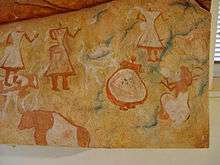
Historically Berber, over the centuries, Libya has been occupied by the Phoenicians, Greeks, Romans, Arabs, and Italians. The Phoenicians had a big impact on Libya. Many of the coastal towns and cities of Libya were founded by the Phoenicians as trade outposts within the southern Mediterranean coast in order to facilitate the Phoenician business activities in the area. Starting in the 8th century BCE, Libya was under the rule of the Phoenician Carthage. After the Romans defeated Carthage in the Third Punic War, Libya became a Roman province under the name of Tripolitania until the 7th century CE when Libya was conquered by the Arab Muslims as part of the Arab conquest of North Africa. Centuries after that, the Ottoman Empire conquered Libya in 1551. It remained in control of its territory until 1911 when the country was conquered by Italy. In the 18th century Libya was used as the base for various pirates.
In the Second World War Libya was one of the main battlegrounds of North Africa. During the war, the territory was under an Anglo-French military government until it was overrun by the Axis Powers, who, in turn, were defeated by the Allies in 1943.
In 1951, the country was granted independence by the United Nations, being governed by King Idris. In 1969, a military coup led by Muammar Gaddafi resulted in the overthrow of King Idris I. Gaddafi then established an anti-Western leadership. In 1970, Gaddafi ordered all British and American military bases closed.
The Libyan population has increased rapidly after 1969. They were only 2 million in 1968, and 5 million in 2006. . Many migrant workers came to Libya since 1969. Among the workers were construction workers and laborers from Tunisia, teachers and laborers from Egypt, teachers from Palestine, and doctors and nurses from Yugoslavia and Bulgaria. 1,000,000 workers, mainly from other neighboring African countries like Sudan, Niger, Chad and Mali, migrated to Libya in the 1990s, after changes were made to Libya's Pan-African policies.[12]
Gaddafi used money from the sale of oil to improve the living conditions of the population and to assist Palestinian guerrillas in their fight against the Israelis. In 1979, Libya fought in Uganda to assist the government of Idi Amin in the Ugandan Civil War, and in 1981, fought in the Libyan-Chadian War. Libya had occupied the Aozou Strip; however, in 1990 the International Court of Justice submitted the case and allowed the full recuperation of territory to Chad.
In September 2008, Italy and Libya signed a memorandum by which Italy would pay $5 billion over the next 20 years to compensate Libya for its dominion over Libya for its reign of 30 years.[13]
Since 2011, the country is swept by Libyan Civil War, which broke out between the Anti-Gaddafi rebels and the Pro-Gaddafi government in 2011, culminating in the death and overthrow of Gaddafi. Nevertheless, even today Libya still continues to generate problems within the area and beyond, greatly affecting its population and the migrant route to Europe.
Population
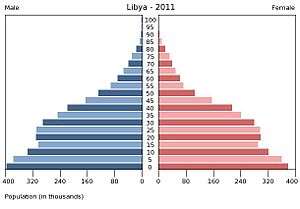
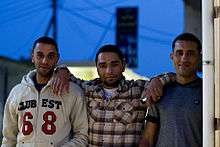
Libya has a small population residing in a large land area. Population density is about 50 persons per km² (130/sq. mi.) in the two northern regions of Tripolitania and Cyrenaica, but falls to less than one person per km² (2.7/sq. mi.) elsewhere. Ninety percent of the people live in less than 10% of the area, primarily along the coast. About 90%[14] of the population is urban, mostly concentrated in the four largest cities, Tripoli, Benghazi, Misrata and Bayda. Thirty percent of the population is estimated to be under the age of 15, but this proportion has decreased considerably during the past decades.
| Total population (x 1000) | Population aged 0–14 (%) | Population aged 15–64 (%) | Population aged 65+ (%) | |
|---|---|---|---|---|
| 1801 | ~ 3 000 | -- | -- | -- |
| 1825 | ~ 3 059 | -- | -- | -- |
| 1850 | ~ 2 700 | -- | -- | -- |
| 1870 | ~ 2 400 | -- | -- | -- |
| 1910 | ~ 1 600 | -- | -- | -- |
| 1950 | 1 029 | 41.9 | 53.4 | 4.7 |
| 1955 | 1 126 | 43.0 | 52.7 | 4.3 |
| 1960 | 1 349 | 43.3 | 52.7 | 4.0 |
| 1965 | 1 623 | 43.4 | 53.0 | 3.6 |
| 1970 | 1 994 | 45.2 | 52.1 | 2.7 |
| 1975 | 2 466 | 46.5 | 51.3 | 2.2 |
| 1980 | 3 063 | 47.0 | 50.7 | 2.2 |
| 1985 | 3 850 | 47.3 | 50.5 | 2.3 |
| 1990 | 4 334 | 43.5 | 53.9 | 2.6 |
| 1995 | 4 775 | 38.3 | 58.8 | 2.9 |
| 2000 | 5 231 | 32.4 | 64.2 | 3.4 |
| 2005 | 5 770 | 30.6 | 65.6 | 3.8 |
| 2010 | 6 355 | 30.4 | 65.3 | 4.3 |
Population census
Eight population censuses have been carried out in Libya, the first in 1931 and the most recent one in 2006.[15][16] The population multiplied sixfold between 1931 and 2006.
| Year | Males (thousands) | Females (thousands) | Total population (thousands) | Average annual growth rate (%) |
|---|---|---|---|---|
| 1931 | 704 | |||
| 1936 | 463 | 386 | 849 | 3.8 |
| 1954 | 564 | 524 | 1,089 | 1.4 |
| 1964 (July 31) | 813 | 751 | 1,564 | 3.7 |
| 1973 (July 31) | 1,192 | 1,057 | 2,249 | 4.1 |
| 1984 (July 31) | 1,954 | 1,689 | 3,643 | 4.5 |
| 1995 (August 11) | 2,237 | 2,168 | 4,405 | 1.7 |
| 2006 (April 15) | 2,934 | 2,723 | 5,658 | 2.3 |
Vital statistics
During the past 60 years the demographic situation of Libya changed considerably. Since the 1950s, life expectancy increased steadily and the infant mortality rates decreased. As the fertility rates remained high until the 1980s (the number of births tripled between 1950–55 and 1980–85), population growth was very high for three decades. However, after 1985 a fast decrease in fertility was observed from over 7 children per woman in the beginning of the 1980s to less than 3 in 2005-2010. Because of this decrease in fertility the population growth slowed down and also the proportion of Libyans under the age of 15 decreased from 47% in 1985 to 30% in 2010.
Births and deaths
| Period | Births | Deaths | Difference | CBR* | CDR* | NC* | IMR* | TFR* |
|---|---|---|---|---|---|---|---|---|
| 1950–1955 | 52,000 | 24,000 | 28,000 | 48.0 | 22.5 | 25.5 | 185.0 | 6.9 |
| 1955–1960 | 60,000 | 25,000 | 35,000 | 48.5 | 19.9 | 28.6 | 170.0 | 7.0 |
| 1960–1965 | 73,000 | 27,000 | 46,000 | 49.0 | 18.3 | 30.7 | 150.0 | 7.2 |
| 1965–1970 | 90,000 | 30,000 | 60,000 | 49.5 | 16.8 | 32.7 | 125.0 | 7.5 |
| 1970–1975 | 109,000 | 33,000 | 76,000 | 49.0 | 14.8 | 34.2 | 105.0 | 7.6 |
| 1975–1980 | 131,000 | 35,000 | 96,000 | 47.3 | 12.7 | 34.6 | 68.0 | 7.4 |
| 1980–1985 | 158,000 | 38,000 | 120,000 | 45.6 | 10.9 | 34.7 | 50.0 | 7.2 |
| 1985–1990 | 123,000 | 22,000 | 101,000 | 29.9 | 5.3 | 24.6 | 38.0 | 5.7 |
| 1990–1995 | 113,000 | 20,000 | 93,000 | 24.7 | 4.5 | 20.2 | 28.3 | 4.1 |
| 1995–2000 | 115,000 | 20,000 | 95,000 | 23.0 | 4.0 | 19.0 | 20.5 | 3.3 |
| 2000–2005 | 134,000 | 22,000 | 112,000 | 24.3 | 4.0 | 20.3 | 17.7 | 3.0 |
| 2005–2010 | 145,000 | 24,000 | 121,000 | 24.0 | 4.0 | 20.0 | 15.0 | 2.7 |
Births and deaths[17]
| Year | Population | Live births | Deaths | Natural increase | Crude birth rate | Crude death rate | Rate of natural increase | TFR |
|---|---|---|---|---|---|---|---|---|
| 2009 | 6,133,987 | 134,682 | 22,859 | 111,823 | 22.0 | 3.7 |
Life expectancy at birth
- 1950-1955: 42.85 years
- 1955-1960: 45.4 years
- 1960-1965: 48.1 years
- 1965-1970: 50.5 years
- 1970-1975: 52.8 years
- 1975-1980: 56.45 years
- 1980-1985: 60.2 years
- 1985-1990: 63.5 years
- 1990-1995: 65.85 years
- 1995-2000: 67.2 years
- 2000-2005: 68.8 years
- 2005-2010: 69.9 years
CIA World Factbook demographic statistics
The following demographic statistics are from the CIA World Factbook, unless otherwise indicated.[18]
Vital statistics
Population
- 6,754,507 (July 2018 est.)
Age structure
- 0-14 years: 25.53% (male 882,099/ female 842,320)
- 15-24 years: 16.81% (male 582,247/ female 553,004)
- 25-54 years: 47.47% (male 1,684,019/ female 1,522,027)
- 55-64 years: 5.77% (male 197,196/ female 192,320)
- 65 years and over: 4.43% (male 147,168/ female 152,107) (2018 est.)
Median age
- total: 29.4 years
- male: 29.5 years
- female: 29.2 years (2018 est.)
Population growth rate
- 1.45% (2018 est.)
Birth rate
- 17.2 births/1,000 population (2018 est.)
Death rate
- 3.7 deaths/1,000 population (2018 est.)
Net migration rate
- 0.9 migrant(s)/1,000 population (2018 est.)
Total fertility rate
- 3.71 children born/woman (2000 est.)
- 3.01 children born/woman (2010 est.)
- 2.12 children born/woman (2012 est.)
- 2.03 children born/woman (2018 est.)
Urbanization
- urban population: 80.1% of total population (2018)
- rate of urbanization: 1.68% annual rate of change (2015-20 est.)
Sex ratio
- at birth: 1.05 male(s)/female
- 0–14 years: 1.05 male(s)/female
- 15–24 years: 1.06 male(s)/female
- 25–54 years: 1.1 male(s)/female
- 55–64 years: 1.04 male(s)/female
- 65 years and over: 1.01 male(s)/female
- total population: 1.07 male(s)/female (2017 est.)
Infant mortality rate
- total: 10.5 deaths/1,000 live births
- male: 11.3 deaths/1,000 live births
- female: 9.6 deaths/1,000 live births (2018 est.)
Life expectancy at birth
- total population: 76.9 years
- male: 75.1 years
- female: 78.7 years (2018 est.)
Ethnic and tribal groups
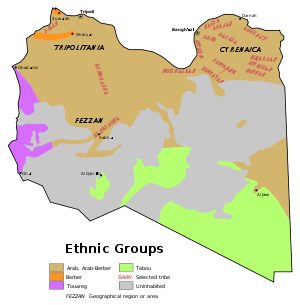
Ethnic groups
Although the CIA World Factbook claims that Libya's population is 97% Arab and Berber,[19] the 1936 census, which allowed citizens to declare their ethnicity, showed a more diverse population:
| Resident native population of Libya (1936 census)[20] | ||
|---|---|---|
| Ethnic group | Population | % of Libya's total population |
| Arab-Berber | 585,902 | 78% |
| Berbers | 70,174 | 9.3% |
| Turks | 35,062 | 4.7% |
| Black | 30,079 | 4% |
| White | 22,530 | 0.4% |
| Others | 29,634 | 4% |
| Libya, Total | 750,851 | 100% |
The population of Libya is primarily of Arab and Berber ancestral origin.[21] Among the non-Arabized Berber groups are the nomadic Tuareg, who inhabit the southern areas as well as parts of Algeria, Mali, Niger and Burkina Faso. A few other tribal groups that still speak the native Berber languages are concentrated in the northwestern portion of Tripolitania. In the southeast, there are small populations of Toubou (Tibbu). They occupy between a quarter and a third of the country and also inhabit Niger and Chad. Among foreign residents, the largest groups are from other African nations, including citizens of other North African nations (primarily Egyptians) and West Africans.
Tribal groups
Libyan society is to a large extent structured along tribal lines, with more than 20 major tribal groups.[22]
The major tribal groups of Libya in 2011 were listed:[22]
- Tripolitania Settled non Bedouin tribes: Misurata Ahali, Misurata Karagula, Geryan, Zawia, Misalata, Zwara Berber, Khumus
- Tripolitania Bedouin tribes: Warfalla, Tarhona, Al-Zintan, Al-Rijban
- Cyrenaica Beduin: Al-Awagir, Al-Abaydat, Drasa, Al-Barasa, Al-Fawakhir, Al-Zuwayya, Al-Majabra
- Sirte Beduin: Qadhadhfa, Al-Magarha, Al-Magharba, Al-Riyyah, Al-Haraba, Al-Zuwaid, Al-Guwaid
- Fezzan: Hutman, Hassawna; Toubou, Tuareg
- Kufra: Al-Zuwayya; Toubou
Some of the ancient Berber tribes include: Adyrmachidae, Auschisae, Es'bet, Temeh’u, Teh’nu, Rebu, Kehek, KeyKesh, Imukehek, Meshwesh, Macetae, Macatutae, Nasamones, Nitriotae, and Tautamaei.[12]
As of 2012 the major tribal groups of Libya, by region, were as follows:[23]
- Tripolitania: alawana-Souk El Joma'a, AL-Mahameed, Warfalla, Tarhona, Misurata tribes, Al-Jawary, Siyan Tribe, The Warshfana tribes, Zawia Groups, Ghryan Tribes, AL-Asabea, Al-Fwatir, Awlad Busayf, Zintan, Al-jbalya, Zwara, Alajelat, Al-Nawael tribe, Alalqa tribe, Al-Rijban, al Mashashi, Amaym.
- Cyrenaica: AJ-JWAZY, Al-Awagir, Magharba, Al-Abaydat, Drasa, Al-Barasa, Al-Fawakhir, Zuwayya, Majabra, Awama, Minfa, Taraki, alawana, Shwa'ir and in Kufra Zuwayya; Toubou.
- Sirte: Awlad-Suleiman, Qadhadhfa, Magharba, Al-Hosoon, Ferrjan
- Fezzan: Awlad Suleiman, Al-Riyyah, Magarha, Al-Zuwaid, Al-Hutman, Al-Hassawna; Toubou, Tuareg.
- Kufra: Zuwayya; Toubou.
Foreign population
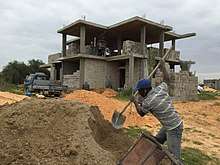
The foreign population is estimated at 3%, most of whom are migrant workers in the oil industry from Tunisia and Egypt, but also including small numbers of Greeks, Maltese, Italians, Pakistanis, Palestinians, Turks, Indians, and people from former Yugoslavia. Due to the Libyan Civil War, most of these migrant workers have returned to their homelands or simply left the country for a different one.
However, according to news accounts in Allafrica.com, and the Libya Herald, between 1 million and 2 million Egyptians are resident in Libya and the Sudanese number in the hundreds of thousands. If this is correct, the foreign population could be as high as 30% of the country, as simultaneously at least two million Libyans have fled since the NATO intervention of 2011, toppling the previous Libyan government.
Genetics
Y-chromosome
Analysis of Y-chromosome have found three Y-chromosome lineages (E1b1b-M81, J-M267 and E1b1b-M78) at high frequency in Libya like in other North African populations. Some studies suggest a Paleolithic component for E-M81 and E-M78, while other studies point to a Neolithic origin. E1b1b-M78 has probably emerged in the Egypt/Libya area and is today widely distributed in North Africa, East Africa, and West Asia. E1b1b-M81 show high frequencies in Northwestern Africa and a high prevalence among Berbers (it is sometimes referred to as a genetic "Berber marker"). Its frequency declines towards Egypt and the Levant. On the other hand, E-M78 and E-M123 are frequent in the Levant and Egypt and decline towards Northwest Africa. Another common paternal lineage in Libya and North Africa is haplogroup J through its subtypes J1 (M267) and J2 (M172). J1 is prevalent in some North African and all Levantine groups and found at high frequencies in the Arabian Peninsula. It has been previously associated with the Islamic expansion. J2 is sporadically detected in North Africa and Iberia and is very frequent in the Levant/Anatolia/Iran region. Its spread in the Mediterranean is believed to have been facilitated by the maritime trading culture of the Phoenicians (1550 BC- 300 BC). E-M2 is the predominant lineage in Western Africa.
Listed here are the human Y-chromosome DNA haplogroups in Libya.[24]
| Hg | Libya (n=215) |
| E-M81 | 35.88% |
| J-M267 | 30.53% |
| E-M78 | 11.07% |
| E-M2 | 8.78% |
| G-M201 | 4.20% |
| J-M172 | 3.44% |
| R* | 3.43% |
| E-M123 | 1.53% |
| E* | 0.76% |
| R-M17 | 0.38% |
Religions
The vast majority Libyans are nominally Sunni Muslim. Almost 3% of the population is Christian, with some local Christian church adherents in Eastern Libya - the Copts. A small Jewish community historically lived in Libya since antiquity (see History of the Jews in Libya), but the entire Jewish community in Libya eventually fled the country for Italy, Israel, or the United States, particularly after anti-Jewish riots in the wake of the 1967 Six-Day War between Arab countries and Israel.
Culture
Cuisine
Libyan cuisine is heavily influenced by Mediterranean, Arabic and North African (Berber cuisine) traditions. Notable dishes include Shorba Arabiya, or Arabian soup, which is a thick, highly spiced soup.[25] Like other Maghrebi countries, couscous and tajine are traditional of Libya. Bazeen is a traditional Libyan food, made from a mix of barley flour and a small amount of plain flour.
Music
Libyan origin instruments are the Zukra (a bagpipe), a flute (made of bamboo), the tambourine, the oud (a fretless lute) and the darbuka (a goblet drum held sideways and played with the fingers). Bedouin poet-singers had a great influence on the musical folklore of Libya, particularly the style of huda, the camel driver's song.
Language
The official language of Libya is Standard Arabic, while the most prevalent spoken language is Libyan Arabic. Berber is also common, spoken by about 300,000 Libyans. Arabic varieties are partly spoken by immigrant workers and partly by local Libyan populations. These varieties include Egyptian, Tunisian, Sudanese, Moroccan, Ta'izzi-Adeni, Hassaniyya and South Levantine Arabic.
Berber languages are primarily still spoken by the Tuareg, a rural Berber population inhabiting Libya's south.[26]
Indigenous minority languages in Libya:[27]
Non-Arabic languages had largely been spoken by foreign workers (who had been massively employed in Libya in various infrastructure projects prior to the 2011 civil war), and those languages with more than 10,000 speakers included Punjabi, Urdu, Mandarin, Cantonese, Korean, Sinhala, Bengal, Tamil, Tagalog, French, Italian, Ukrainian, Serbian, and English.
References
| Wikimedia Commons has media related to Demographics of Libya. |
- "Libya". CIA World Factbook. Retrieved 20 September 2015.
- "الشؤون الاجتماعية : هذا عدد الليبيين المقيمين بتونس". Retrieved 7 October 2018.
- "Libyans in Egypt losing hope of returning home". Retrieved 7 October 2018.
- EU Migration Policy Centre. "Migration Facts Libya April 2013" (PDF). Retrieved 26 December 2016.
- Statistics Canada. "2011 National Household Survey: Data tables". Retrieved 11 February 2014.
- "Libyan Canadians cast ballots in first post-Gadhafi election - iPolitics". ipolitics.ca. 3 July 2012. Retrieved 1 April 2018.
- Serbian Government. "MMIGRATION PROFILE OF THE REPUBLIC OF SERBIA FOR 2014" (PDF). Archived from the original (PDF) on 6 December 2017. Retrieved 11 April 2016.
- https://www.census.gov/population/socdemo/ancestry/ancestry_q_by_DAC_2000.xls
- ""World Population prospects – Population division"". population.un.org. United Nations Department of Economic and Social Affairs, Population Division. Retrieved November 9, 2019.
- ""Overall total population" – World Population Prospects: The 2019 Revision" (xslx). population.un.org (custom data acquired via website). United Nations Department of Economic and Social Affairs, Population Division. Retrieved November 9, 2019.
- World Population Prospects: The 2010 Revision Archived May 6, 2011, at the Wayback Machine
- http://www.temehu.com/Libyan-People.htm Temehu. Libyan people and Ethnic tribes. Retrieved 4 January 2011.
- http://www.hejleh.com/countries/libya.html The Country & People of Libya. Posted 2003. Retrieved January 4, 2012, to 23:53 pm.
- "Save BIG with $9.99 .COMs from GoDaddy!". Go Daddy. Retrieved 1 April 2018.
- B.R. Mitchell. International historical statistics: Africa, Asia & Oceania 1750-2000.
- "United nations. Demographic Yearbooks 1948-2008". un.org. Retrieved 1 April 2018.
- "United Nations Statistics Division - Demographic and Social Statistics". un.org. Retrieved 1 April 2018.
- "The World Factbook — Central Intelligence Agency". www.cia.gov. Retrieved 1 April 2018.
- "Africa :: LIBYA". CIA The World Factbook.
- Pan, Chia-Lin (1949), "The Population of Libya", Population Studies, 3 (1): 100–125, doi:10.1080/00324728.1949.10416359
- "Population of Libya". Fanack.com. Retrieved 2019-06-27.
- Editorial, Reuters. "UPDATE 1-FACTBOX-Tribal ties key to Gaddafi rule". reuters.com. Retrieved 1 April 2018.
- Souhail Karam, Jon Hemming, Tribal ties key to Gaddafi rule, Reuters (2011)
- Karima Fadhlaoui-Zid et al. (2013) Genome-Wide and Paternal Diversity Reveal a Recent Origin of Human Populations in North Africa. PLoS One. 2013; 8(11): e80293. See Table S2
- Served as "starter", the soup is mentioned in the New York Times
- "Libyan People". www.libyaweb.com. Retrieved 1 April 2018.
- (in English) Ethnologue report for Libya, Languages of Libya
